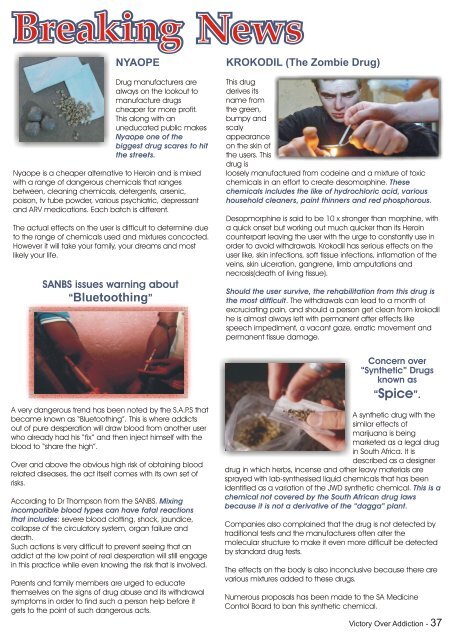Victory Over Addiction
This is our Drug Awareness Campaign Magazine that will be distributed nationally to inform parents and business owners about the implications and dangers regarding drug and substance abuse
This is our Drug Awareness Campaign Magazine that will be distributed nationally to inform parents and business owners about the implications and dangers regarding drug and substance abuse
Create successful ePaper yourself
Turn your PDF publications into a flip-book with our unique Google optimized e-Paper software.
Breaking<br />
NYAOPE<br />
News<br />
KROKODIL (The Zombie Drug)<br />
Drug manufacturers are<br />
always on the lookout to<br />
manufacture drugs<br />
cheaper for more profit.<br />
This along with an<br />
uneducated public makes<br />
Nyaope one of the<br />
biggest drug scares to hit<br />
the streets.<br />
Nyaope is a cheaper alternative to Heroin and is mixed<br />
with a range of dangerous chemicals that ranges<br />
between, cleaning chemicals, detergents, arsenic,<br />
poison, tv tube powder, various psychiatric, depressant<br />
and ARV medications. Each batch is different.<br />
The actual effects on the user is difficult to determine due<br />
to the range of chemicals used and mixtures concocted.<br />
However it will take your family, your dreams and most<br />
likely your life.<br />
SANBS issues warning about<br />
“Bluetoothing”<br />
This drug<br />
derives its<br />
name from<br />
the green,<br />
bumpy and<br />
scaly<br />
appearance<br />
on the skin of<br />
the users. This<br />
drug is<br />
loosely manufactured from codeine and a mixture of toxic<br />
chemicals in an effort to create desomorphine. These<br />
chemicals includes the like of hydrochloric acid, various<br />
household cleaners, paint thinners and red phosphorous.<br />
Desopmorphine is said to be 10 x stronger than morphine, with<br />
a quick onset but working out much quicker than its Heroin<br />
counterpart leaving the user with the urge to constantly use in<br />
order to avoid withdrawals. Krokodil has serious effects on the<br />
user like, skin infections, soft tissue infections, inflamation of the<br />
veins, skin ulceration, gangrene, limb amputations and<br />
necrosis(death of living tissue).<br />
Should the user survive, the rehabilitation from this drug is<br />
the most difficult. The withdrawals can lead to a month of<br />
excruciating pain, and should a person get clean from krokodil<br />
he is almost always left with permanent after effects like<br />
speech impediment, a vacant gaze, erratic movement and<br />
permanent tissue damage.<br />
A very dangerous trend has been noted by the S.A.P.S that<br />
became known as “Bluetoothing”. This is where addicts<br />
out of pure desperation will draw blood from another user<br />
who already had his “fix” and then inject himself with the<br />
blood to “share the high”.<br />
<strong>Over</strong> and above the obvious high risk of obtaining blood<br />
related diseases, the act itself comes with its own set of<br />
risks.<br />
According to Dr Thompson from the SANBS. Mixing<br />
incompatible blood types can have fatal reactions<br />
that includes: severe blood clotting, shock, jaundice,<br />
collapse of the circulatory system, organ failure and<br />
death.<br />
Such actions is very difficult to prevent seeing that an<br />
addict at the low point of real desperation will still engage<br />
in this practice while even knowing the risk that is involved.<br />
Parents and family members are urged to educate<br />
themselves on the signs of drug abuse and its withdrawal<br />
symptoms in order to find such a person help before it<br />
gets to the point of such dangerous acts.<br />
Concern over<br />
“Synthetic” Drugs<br />
known as<br />
“Spice”.<br />
A synthetic drug with the<br />
similar effects of<br />
marijuana is being<br />
marketed as a legal drug<br />
in South Africa. It is<br />
described as a designer<br />
drug in which herbs, incense and other leavy materials are<br />
sprayed with lab-synthesised liquid chemicals that has been<br />
identified as a variation of the JWD synthetic chemical. This is a<br />
chemical not covered by the South African drug laws<br />
because it is not a derivative of the “dagga” plant.<br />
Companies also complained that the drug is not detected by<br />
traditional tests and the manufacturers often alter the<br />
molecular structure to make it even more difficult be detected<br />
by standard drug tests.<br />
The effects on the body is also inconclusive because there are<br />
various mixtures added to these drugs.<br />
Numerous proposals has been made to the SA Medicine<br />
Control Board to ban this synthetic chemical.<br />
<strong>Victory</strong> <strong>Over</strong> <strong>Addiction</strong> - 37



